Analysis of Ineffective Hand Hygiene Among Nurses in Australian SICU
VerifiedAdded on 2023/03/23
|10
|2574
|51
Report
AI Summary
This report addresses the critical issue of ineffective hand hygiene among nurses in the Surgical Intensive Care Unit (SICU) in Australia. It begins by outlining the context of the problem, highlighting the importance of hand hygiene in preventing healthcare-associated infections (HAIs) and the current low compliance rates. The report emphasizes the need for change, detailing the risks associated with poor hand hygiene, particularly in a high-risk environment like the SICU. It identifies various barriers to effective hand hygiene, including lack of knowledge, time constraints, inadequate resources, and a culture that does not prioritize hand hygiene. Furthermore, the report discusses the leadership skills and attributes necessary to facilitate and evaluate change, such as dedication to excellence, communication skills, critical thinking, integrity, and professionalism. The author concludes by reiterating the importance of hand hygiene and recommending strategies to improve compliance and ensure patient safety. The analysis underscores the role of nurses in preventing the spread of infections and promoting better healthcare outcomes. The report serves as a call to action for healthcare professionals to prioritize hand hygiene practices.
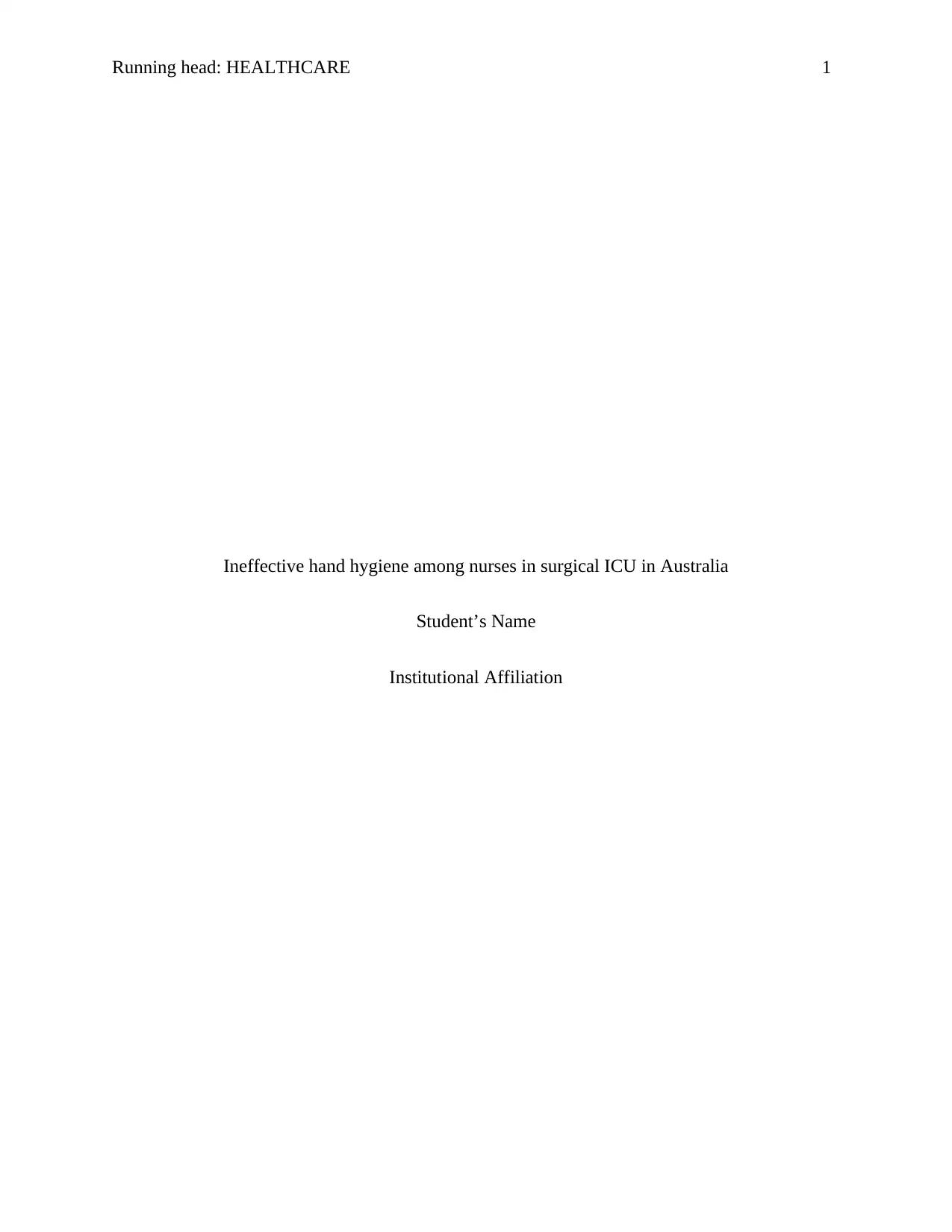
Running head: HEALTHCARE 1
Ineffective hand hygiene among nurses in surgical ICU in Australia
Student’s Name
Institutional Affiliation
Ineffective hand hygiene among nurses in surgical ICU in Australia
Student’s Name
Institutional Affiliation
Paraphrase This Document
Need a fresh take? Get an instant paraphrase of this document with our AI Paraphraser
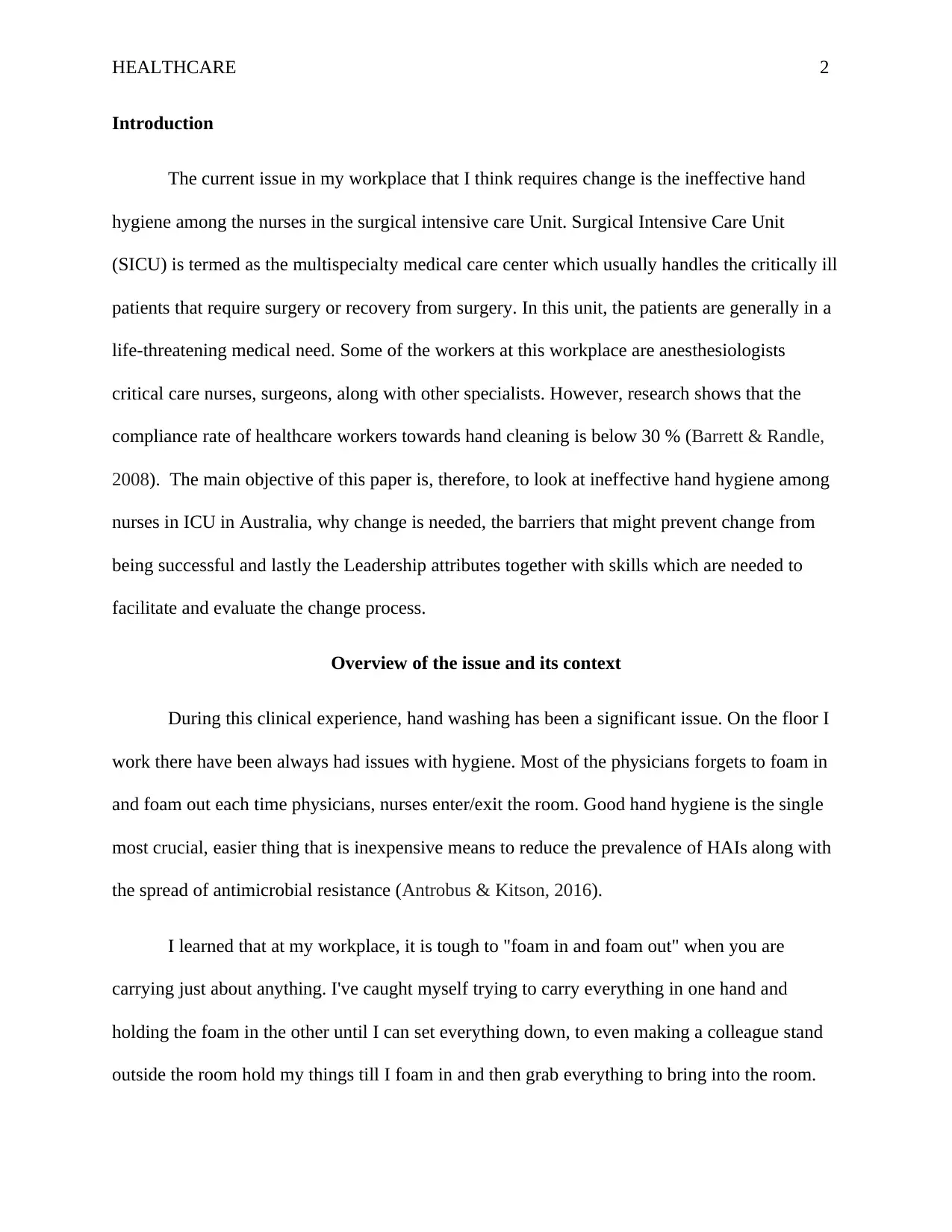
HEALTHCARE 2
Introduction
The current issue in my workplace that I think requires change is the ineffective hand
hygiene among the nurses in the surgical intensive care Unit. Surgical Intensive Care Unit
(SICU) is termed as the multispecialty medical care center which usually handles the critically ill
patients that require surgery or recovery from surgery. In this unit, the patients are generally in a
life-threatening medical need. Some of the workers at this workplace are anesthesiologists
critical care nurses, surgeons, along with other specialists. However, research shows that the
compliance rate of healthcare workers towards hand cleaning is below 30 % (Barrett & Randle,
2008). The main objective of this paper is, therefore, to look at ineffective hand hygiene among
nurses in ICU in Australia, why change is needed, the barriers that might prevent change from
being successful and lastly the Leadership attributes together with skills which are needed to
facilitate and evaluate the change process.
Overview of the issue and its context
During this clinical experience, hand washing has been a significant issue. On the floor I
work there have been always had issues with hygiene. Most of the physicians forgets to foam in
and foam out each time physicians, nurses enter/exit the room. Good hand hygiene is the single
most crucial, easier thing that is inexpensive means to reduce the prevalence of HAIs along with
the spread of antimicrobial resistance (Antrobus & Kitson, 2016).
I learned that at my workplace, it is tough to "foam in and foam out" when you are
carrying just about anything. I've caught myself trying to carry everything in one hand and
holding the foam in the other until I can set everything down, to even making a colleague stand
outside the room hold my things till I foam in and then grab everything to bring into the room.
Introduction
The current issue in my workplace that I think requires change is the ineffective hand
hygiene among the nurses in the surgical intensive care Unit. Surgical Intensive Care Unit
(SICU) is termed as the multispecialty medical care center which usually handles the critically ill
patients that require surgery or recovery from surgery. In this unit, the patients are generally in a
life-threatening medical need. Some of the workers at this workplace are anesthesiologists
critical care nurses, surgeons, along with other specialists. However, research shows that the
compliance rate of healthcare workers towards hand cleaning is below 30 % (Barrett & Randle,
2008). The main objective of this paper is, therefore, to look at ineffective hand hygiene among
nurses in ICU in Australia, why change is needed, the barriers that might prevent change from
being successful and lastly the Leadership attributes together with skills which are needed to
facilitate and evaluate the change process.
Overview of the issue and its context
During this clinical experience, hand washing has been a significant issue. On the floor I
work there have been always had issues with hygiene. Most of the physicians forgets to foam in
and foam out each time physicians, nurses enter/exit the room. Good hand hygiene is the single
most crucial, easier thing that is inexpensive means to reduce the prevalence of HAIs along with
the spread of antimicrobial resistance (Antrobus & Kitson, 2016).
I learned that at my workplace, it is tough to "foam in and foam out" when you are
carrying just about anything. I've caught myself trying to carry everything in one hand and
holding the foam in the other until I can set everything down, to even making a colleague stand
outside the room hold my things till I foam in and then grab everything to bring into the room.
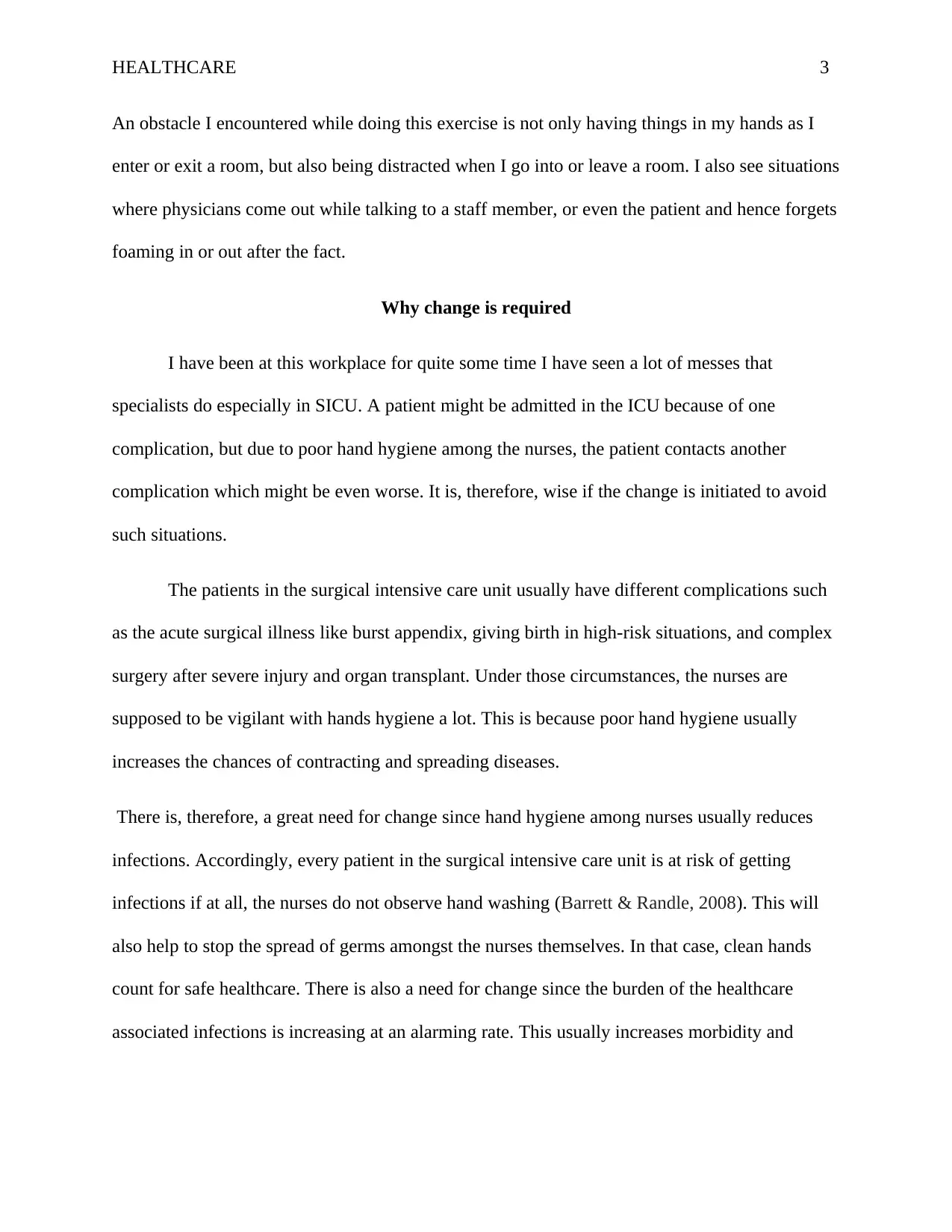
HEALTHCARE 3
An obstacle I encountered while doing this exercise is not only having things in my hands as I
enter or exit a room, but also being distracted when I go into or leave a room. I also see situations
where physicians come out while talking to a staff member, or even the patient and hence forgets
foaming in or out after the fact.
Why change is required
I have been at this workplace for quite some time I have seen a lot of messes that
specialists do especially in SICU. A patient might be admitted in the ICU because of one
complication, but due to poor hand hygiene among the nurses, the patient contacts another
complication which might be even worse. It is, therefore, wise if the change is initiated to avoid
such situations.
The patients in the surgical intensive care unit usually have different complications such
as the acute surgical illness like burst appendix, giving birth in high-risk situations, and complex
surgery after severe injury and organ transplant. Under those circumstances, the nurses are
supposed to be vigilant with hands hygiene a lot. This is because poor hand hygiene usually
increases the chances of contracting and spreading diseases.
There is, therefore, a great need for change since hand hygiene among nurses usually reduces
infections. Accordingly, every patient in the surgical intensive care unit is at risk of getting
infections if at all, the nurses do not observe hand washing (Barrett & Randle, 2008). This will
also help to stop the spread of germs amongst the nurses themselves. In that case, clean hands
count for safe healthcare. There is also a need for change since the burden of the healthcare
associated infections is increasing at an alarming rate. This usually increases morbidity and
An obstacle I encountered while doing this exercise is not only having things in my hands as I
enter or exit a room, but also being distracted when I go into or leave a room. I also see situations
where physicians come out while talking to a staff member, or even the patient and hence forgets
foaming in or out after the fact.
Why change is required
I have been at this workplace for quite some time I have seen a lot of messes that
specialists do especially in SICU. A patient might be admitted in the ICU because of one
complication, but due to poor hand hygiene among the nurses, the patient contacts another
complication which might be even worse. It is, therefore, wise if the change is initiated to avoid
such situations.
The patients in the surgical intensive care unit usually have different complications such
as the acute surgical illness like burst appendix, giving birth in high-risk situations, and complex
surgery after severe injury and organ transplant. Under those circumstances, the nurses are
supposed to be vigilant with hands hygiene a lot. This is because poor hand hygiene usually
increases the chances of contracting and spreading diseases.
There is, therefore, a great need for change since hand hygiene among nurses usually reduces
infections. Accordingly, every patient in the surgical intensive care unit is at risk of getting
infections if at all, the nurses do not observe hand washing (Barrett & Randle, 2008). This will
also help to stop the spread of germs amongst the nurses themselves. In that case, clean hands
count for safe healthcare. There is also a need for change since the burden of the healthcare
associated infections is increasing at an alarming rate. This usually increases morbidity and
⊘ This is a preview!⊘
Do you want full access?
Subscribe today to unlock all pages.

Trusted by 1+ million students worldwide
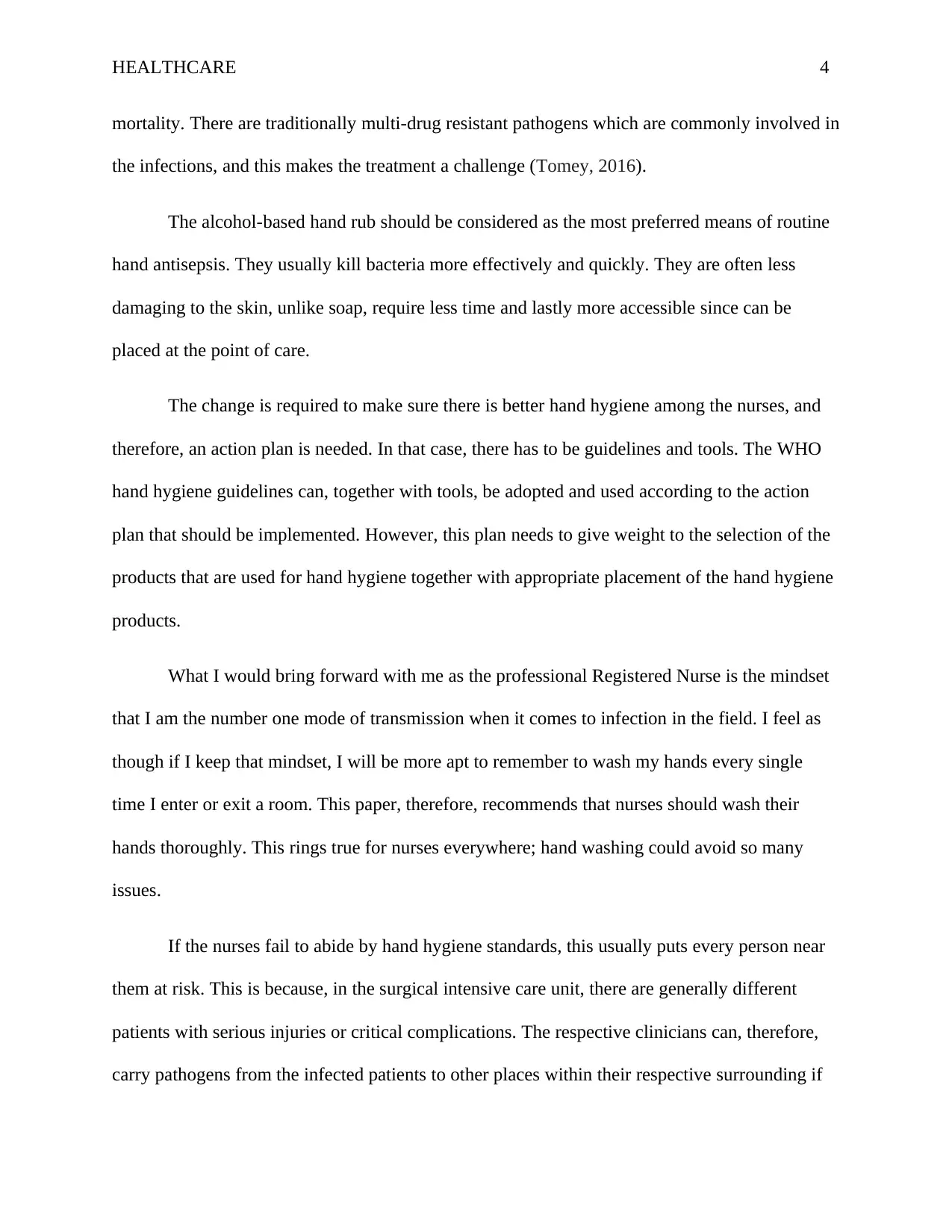
HEALTHCARE 4
mortality. There are traditionally multi-drug resistant pathogens which are commonly involved in
the infections, and this makes the treatment a challenge (Tomey, 2016).
The alcohol-based hand rub should be considered as the most preferred means of routine
hand antisepsis. They usually kill bacteria more effectively and quickly. They are often less
damaging to the skin, unlike soap, require less time and lastly more accessible since can be
placed at the point of care.
The change is required to make sure there is better hand hygiene among the nurses, and
therefore, an action plan is needed. In that case, there has to be guidelines and tools. The WHO
hand hygiene guidelines can, together with tools, be adopted and used according to the action
plan that should be implemented. However, this plan needs to give weight to the selection of the
products that are used for hand hygiene together with appropriate placement of the hand hygiene
products.
What I would bring forward with me as the professional Registered Nurse is the mindset
that I am the number one mode of transmission when it comes to infection in the field. I feel as
though if I keep that mindset, I will be more apt to remember to wash my hands every single
time I enter or exit a room. This paper, therefore, recommends that nurses should wash their
hands thoroughly. This rings true for nurses everywhere; hand washing could avoid so many
issues.
If the nurses fail to abide by hand hygiene standards, this usually puts every person near
them at risk. This is because, in the surgical intensive care unit, there are generally different
patients with serious injuries or critical complications. The respective clinicians can, therefore,
carry pathogens from the infected patients to other places within their respective surrounding if
mortality. There are traditionally multi-drug resistant pathogens which are commonly involved in
the infections, and this makes the treatment a challenge (Tomey, 2016).
The alcohol-based hand rub should be considered as the most preferred means of routine
hand antisepsis. They usually kill bacteria more effectively and quickly. They are often less
damaging to the skin, unlike soap, require less time and lastly more accessible since can be
placed at the point of care.
The change is required to make sure there is better hand hygiene among the nurses, and
therefore, an action plan is needed. In that case, there has to be guidelines and tools. The WHO
hand hygiene guidelines can, together with tools, be adopted and used according to the action
plan that should be implemented. However, this plan needs to give weight to the selection of the
products that are used for hand hygiene together with appropriate placement of the hand hygiene
products.
What I would bring forward with me as the professional Registered Nurse is the mindset
that I am the number one mode of transmission when it comes to infection in the field. I feel as
though if I keep that mindset, I will be more apt to remember to wash my hands every single
time I enter or exit a room. This paper, therefore, recommends that nurses should wash their
hands thoroughly. This rings true for nurses everywhere; hand washing could avoid so many
issues.
If the nurses fail to abide by hand hygiene standards, this usually puts every person near
them at risk. This is because, in the surgical intensive care unit, there are generally different
patients with serious injuries or critical complications. The respective clinicians can, therefore,
carry pathogens from the infected patients to other places within their respective surrounding if
Paraphrase This Document
Need a fresh take? Get an instant paraphrase of this document with our AI Paraphraser
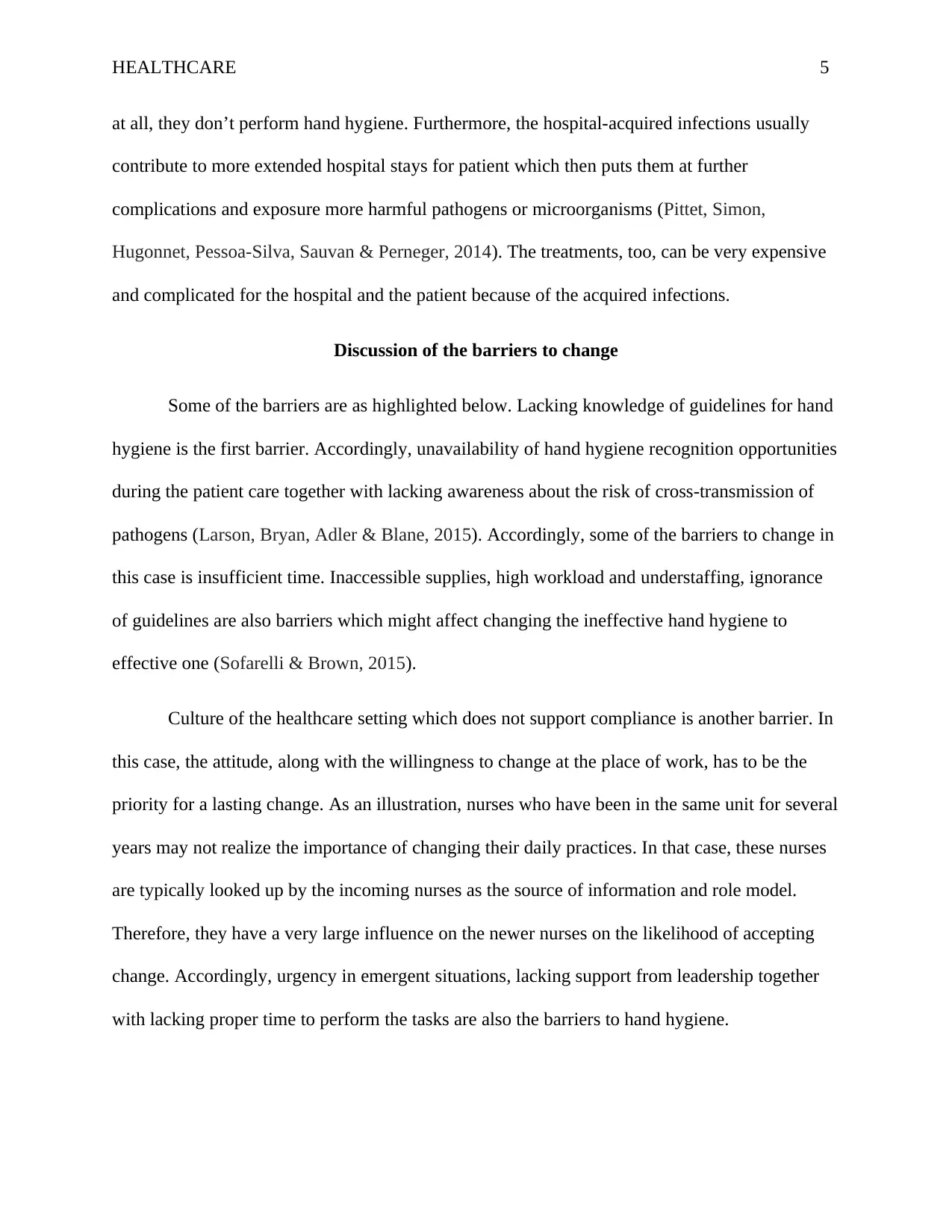
HEALTHCARE 5
at all, they don’t perform hand hygiene. Furthermore, the hospital-acquired infections usually
contribute to more extended hospital stays for patient which then puts them at further
complications and exposure more harmful pathogens or microorganisms (Pittet, Simon,
Hugonnet, Pessoa-Silva, Sauvan & Perneger, 2014). The treatments, too, can be very expensive
and complicated for the hospital and the patient because of the acquired infections.
Discussion of the barriers to change
Some of the barriers are as highlighted below. Lacking knowledge of guidelines for hand
hygiene is the first barrier. Accordingly, unavailability of hand hygiene recognition opportunities
during the patient care together with lacking awareness about the risk of cross-transmission of
pathogens (Larson, Bryan, Adler & Blane, 2015). Accordingly, some of the barriers to change in
this case is insufficient time. Inaccessible supplies, high workload and understaffing, ignorance
of guidelines are also barriers which might affect changing the ineffective hand hygiene to
effective one (Sofarelli & Brown, 2015).
Culture of the healthcare setting which does not support compliance is another barrier. In
this case, the attitude, along with the willingness to change at the place of work, has to be the
priority for a lasting change. As an illustration, nurses who have been in the same unit for several
years may not realize the importance of changing their daily practices. In that case, these nurses
are typically looked up by the incoming nurses as the source of information and role model.
Therefore, they have a very large influence on the newer nurses on the likelihood of accepting
change. Accordingly, urgency in emergent situations, lacking support from leadership together
with lacking proper time to perform the tasks are also the barriers to hand hygiene.
at all, they don’t perform hand hygiene. Furthermore, the hospital-acquired infections usually
contribute to more extended hospital stays for patient which then puts them at further
complications and exposure more harmful pathogens or microorganisms (Pittet, Simon,
Hugonnet, Pessoa-Silva, Sauvan & Perneger, 2014). The treatments, too, can be very expensive
and complicated for the hospital and the patient because of the acquired infections.
Discussion of the barriers to change
Some of the barriers are as highlighted below. Lacking knowledge of guidelines for hand
hygiene is the first barrier. Accordingly, unavailability of hand hygiene recognition opportunities
during the patient care together with lacking awareness about the risk of cross-transmission of
pathogens (Larson, Bryan, Adler & Blane, 2015). Accordingly, some of the barriers to change in
this case is insufficient time. Inaccessible supplies, high workload and understaffing, ignorance
of guidelines are also barriers which might affect changing the ineffective hand hygiene to
effective one (Sofarelli & Brown, 2015).
Culture of the healthcare setting which does not support compliance is another barrier. In
this case, the attitude, along with the willingness to change at the place of work, has to be the
priority for a lasting change. As an illustration, nurses who have been in the same unit for several
years may not realize the importance of changing their daily practices. In that case, these nurses
are typically looked up by the incoming nurses as the source of information and role model.
Therefore, they have a very large influence on the newer nurses on the likelihood of accepting
change. Accordingly, urgency in emergent situations, lacking support from leadership together
with lacking proper time to perform the tasks are also the barriers to hand hygiene.
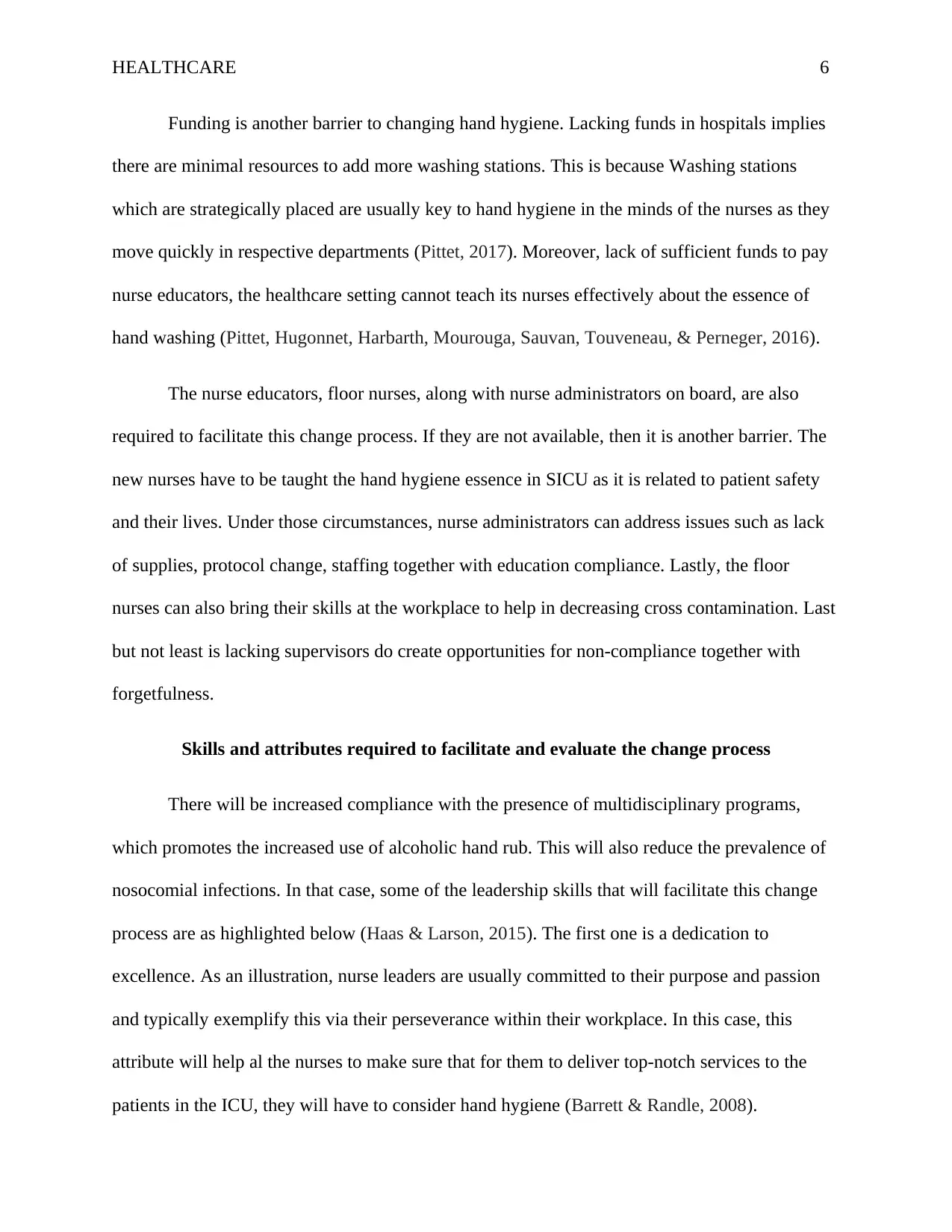
HEALTHCARE 6
Funding is another barrier to changing hand hygiene. Lacking funds in hospitals implies
there are minimal resources to add more washing stations. This is because Washing stations
which are strategically placed are usually key to hand hygiene in the minds of the nurses as they
move quickly in respective departments (Pittet, 2017). Moreover, lack of sufficient funds to pay
nurse educators, the healthcare setting cannot teach its nurses effectively about the essence of
hand washing (Pittet, Hugonnet, Harbarth, Mourouga, Sauvan, Touveneau, & Perneger, 2016).
The nurse educators, floor nurses, along with nurse administrators on board, are also
required to facilitate this change process. If they are not available, then it is another barrier. The
new nurses have to be taught the hand hygiene essence in SICU as it is related to patient safety
and their lives. Under those circumstances, nurse administrators can address issues such as lack
of supplies, protocol change, staffing together with education compliance. Lastly, the floor
nurses can also bring their skills at the workplace to help in decreasing cross contamination. Last
but not least is lacking supervisors do create opportunities for non-compliance together with
forgetfulness.
Skills and attributes required to facilitate and evaluate the change process
There will be increased compliance with the presence of multidisciplinary programs,
which promotes the increased use of alcoholic hand rub. This will also reduce the prevalence of
nosocomial infections. In that case, some of the leadership skills that will facilitate this change
process are as highlighted below (Haas & Larson, 2015). The first one is a dedication to
excellence. As an illustration, nurse leaders are usually committed to their purpose and passion
and typically exemplify this via their perseverance within their workplace. In this case, this
attribute will help al the nurses to make sure that for them to deliver top-notch services to the
patients in the ICU, they will have to consider hand hygiene (Barrett & Randle, 2008).
Funding is another barrier to changing hand hygiene. Lacking funds in hospitals implies
there are minimal resources to add more washing stations. This is because Washing stations
which are strategically placed are usually key to hand hygiene in the minds of the nurses as they
move quickly in respective departments (Pittet, 2017). Moreover, lack of sufficient funds to pay
nurse educators, the healthcare setting cannot teach its nurses effectively about the essence of
hand washing (Pittet, Hugonnet, Harbarth, Mourouga, Sauvan, Touveneau, & Perneger, 2016).
The nurse educators, floor nurses, along with nurse administrators on board, are also
required to facilitate this change process. If they are not available, then it is another barrier. The
new nurses have to be taught the hand hygiene essence in SICU as it is related to patient safety
and their lives. Under those circumstances, nurse administrators can address issues such as lack
of supplies, protocol change, staffing together with education compliance. Lastly, the floor
nurses can also bring their skills at the workplace to help in decreasing cross contamination. Last
but not least is lacking supervisors do create opportunities for non-compliance together with
forgetfulness.
Skills and attributes required to facilitate and evaluate the change process
There will be increased compliance with the presence of multidisciplinary programs,
which promotes the increased use of alcoholic hand rub. This will also reduce the prevalence of
nosocomial infections. In that case, some of the leadership skills that will facilitate this change
process are as highlighted below (Haas & Larson, 2015). The first one is a dedication to
excellence. As an illustration, nurse leaders are usually committed to their purpose and passion
and typically exemplify this via their perseverance within their workplace. In this case, this
attribute will help al the nurses to make sure that for them to deliver top-notch services to the
patients in the ICU, they will have to consider hand hygiene (Barrett & Randle, 2008).
⊘ This is a preview!⊘
Do you want full access?
Subscribe today to unlock all pages.

Trusted by 1+ million students worldwide
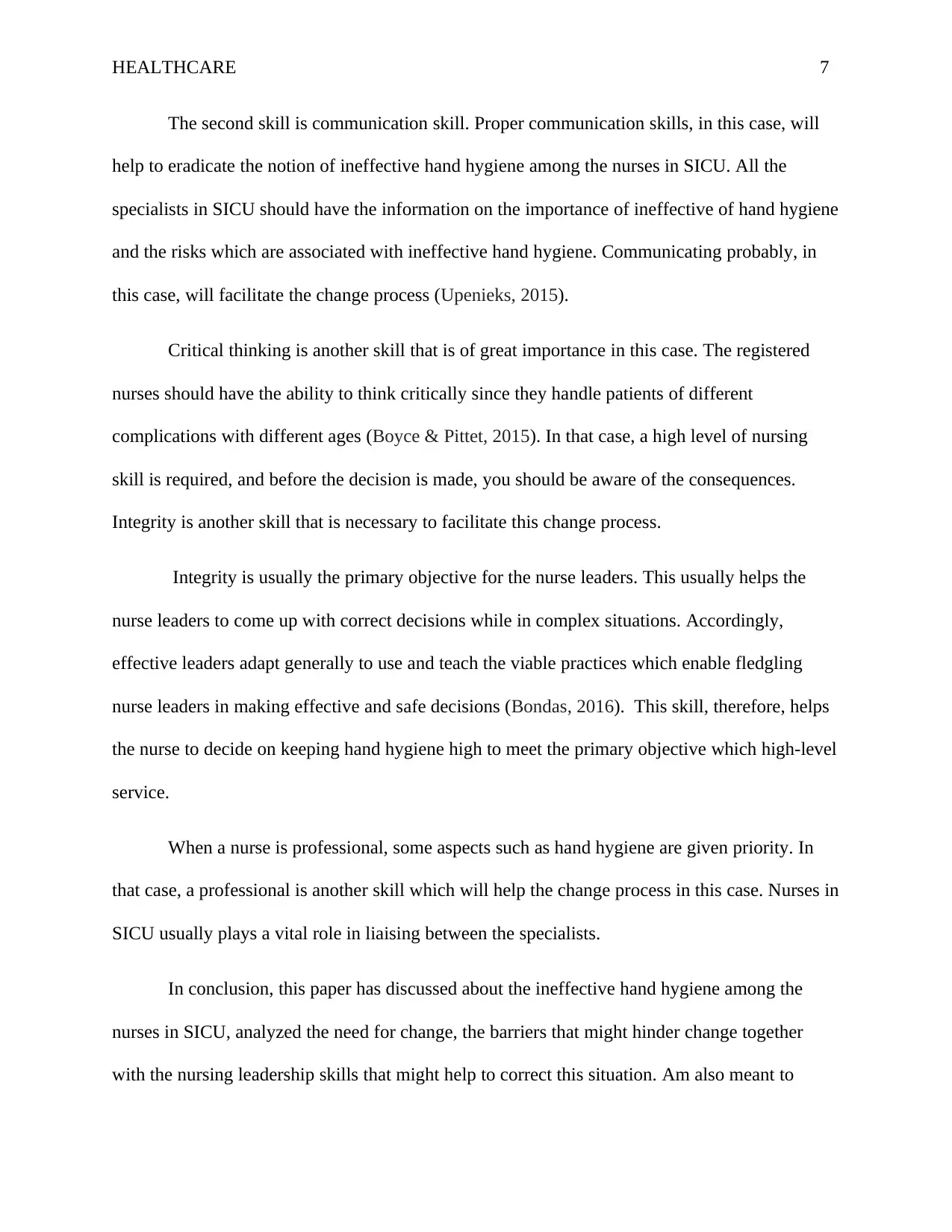
HEALTHCARE 7
The second skill is communication skill. Proper communication skills, in this case, will
help to eradicate the notion of ineffective hand hygiene among the nurses in SICU. All the
specialists in SICU should have the information on the importance of ineffective of hand hygiene
and the risks which are associated with ineffective hand hygiene. Communicating probably, in
this case, will facilitate the change process (Upenieks, 2015).
Critical thinking is another skill that is of great importance in this case. The registered
nurses should have the ability to think critically since they handle patients of different
complications with different ages (Boyce & Pittet, 2015). In that case, a high level of nursing
skill is required, and before the decision is made, you should be aware of the consequences.
Integrity is another skill that is necessary to facilitate this change process.
Integrity is usually the primary objective for the nurse leaders. This usually helps the
nurse leaders to come up with correct decisions while in complex situations. Accordingly,
effective leaders adapt generally to use and teach the viable practices which enable fledgling
nurse leaders in making effective and safe decisions (Bondas, 2016). This skill, therefore, helps
the nurse to decide on keeping hand hygiene high to meet the primary objective which high-level
service.
When a nurse is professional, some aspects such as hand hygiene are given priority. In
that case, a professional is another skill which will help the change process in this case. Nurses in
SICU usually plays a vital role in liaising between the specialists.
In conclusion, this paper has discussed about the ineffective hand hygiene among the
nurses in SICU, analyzed the need for change, the barriers that might hinder change together
with the nursing leadership skills that might help to correct this situation. Am also meant to
The second skill is communication skill. Proper communication skills, in this case, will
help to eradicate the notion of ineffective hand hygiene among the nurses in SICU. All the
specialists in SICU should have the information on the importance of ineffective of hand hygiene
and the risks which are associated with ineffective hand hygiene. Communicating probably, in
this case, will facilitate the change process (Upenieks, 2015).
Critical thinking is another skill that is of great importance in this case. The registered
nurses should have the ability to think critically since they handle patients of different
complications with different ages (Boyce & Pittet, 2015). In that case, a high level of nursing
skill is required, and before the decision is made, you should be aware of the consequences.
Integrity is another skill that is necessary to facilitate this change process.
Integrity is usually the primary objective for the nurse leaders. This usually helps the
nurse leaders to come up with correct decisions while in complex situations. Accordingly,
effective leaders adapt generally to use and teach the viable practices which enable fledgling
nurse leaders in making effective and safe decisions (Bondas, 2016). This skill, therefore, helps
the nurse to decide on keeping hand hygiene high to meet the primary objective which high-level
service.
When a nurse is professional, some aspects such as hand hygiene are given priority. In
that case, a professional is another skill which will help the change process in this case. Nurses in
SICU usually plays a vital role in liaising between the specialists.
In conclusion, this paper has discussed about the ineffective hand hygiene among the
nurses in SICU, analyzed the need for change, the barriers that might hinder change together
with the nursing leadership skills that might help to correct this situation. Am also meant to
Paraphrase This Document
Need a fresh take? Get an instant paraphrase of this document with our AI Paraphraser

HEALTHCARE 8
understand that indeed hand hygiene is very crucial especially the in the surgical intensive care
unit. I would therefore wish to let all the nurses know about the dangers of the ineffective hand
hygiene and what should be done.
understand that indeed hand hygiene is very crucial especially the in the surgical intensive care
unit. I would therefore wish to let all the nurses know about the dangers of the ineffective hand
hygiene and what should be done.
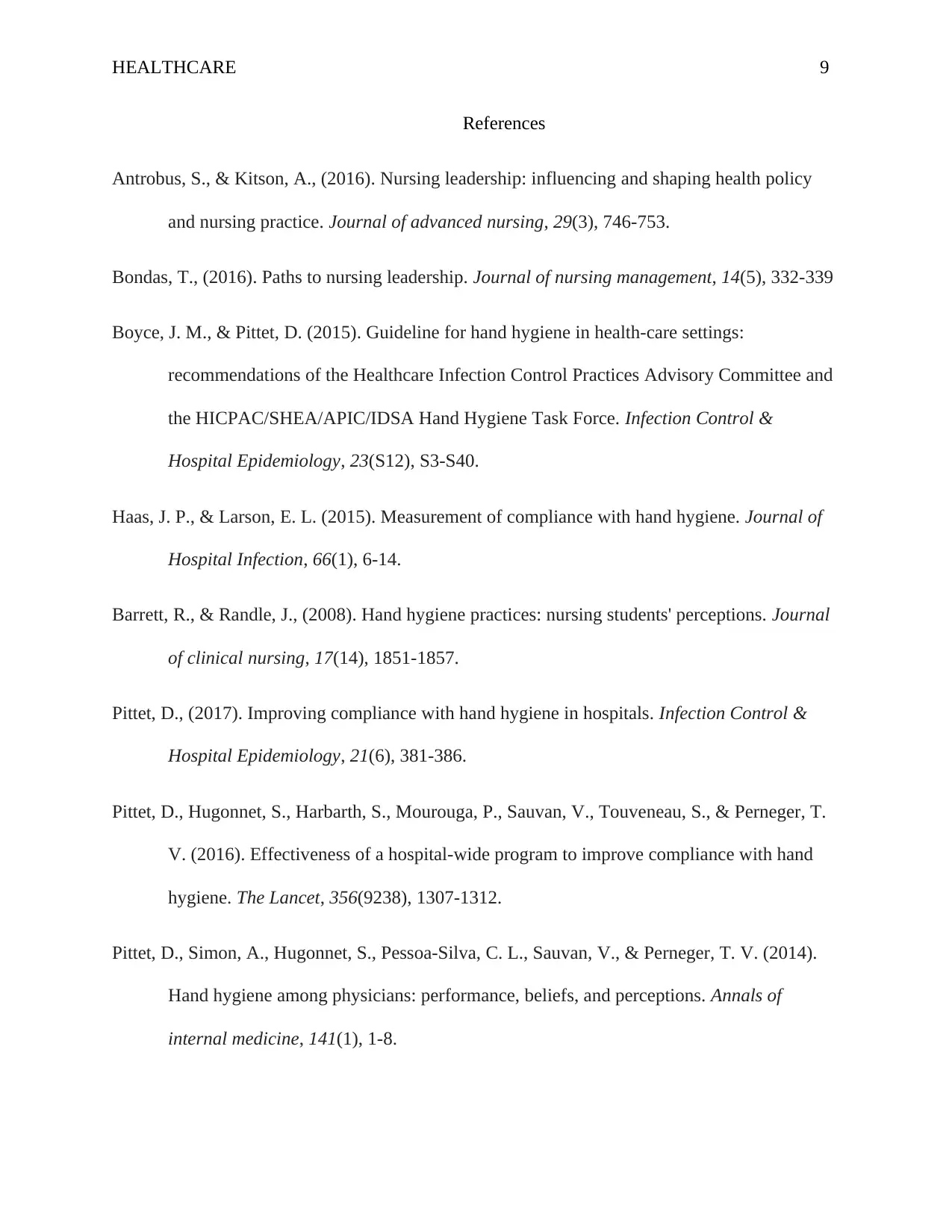
HEALTHCARE 9
References
Antrobus, S., & Kitson, A., (2016). Nursing leadership: influencing and shaping health policy
and nursing practice. Journal of advanced nursing, 29(3), 746-753.
Bondas, T., (2016). Paths to nursing leadership. Journal of nursing management, 14(5), 332-339
Boyce, J. M., & Pittet, D. (2015). Guideline for hand hygiene in health-care settings:
recommendations of the Healthcare Infection Control Practices Advisory Committee and
the HICPAC/SHEA/APIC/IDSA Hand Hygiene Task Force. Infection Control &
Hospital Epidemiology, 23(S12), S3-S40.
Haas, J. P., & Larson, E. L. (2015). Measurement of compliance with hand hygiene. Journal of
Hospital Infection, 66(1), 6-14.
Barrett, R., & Randle, J., (2008). Hand hygiene practices: nursing students' perceptions. Journal
of clinical nursing, 17(14), 1851-1857.
Pittet, D., (2017). Improving compliance with hand hygiene in hospitals. Infection Control &
Hospital Epidemiology, 21(6), 381-386.
Pittet, D., Hugonnet, S., Harbarth, S., Mourouga, P., Sauvan, V., Touveneau, S., & Perneger, T.
V. (2016). Effectiveness of a hospital-wide program to improve compliance with hand
hygiene. The Lancet, 356(9238), 1307-1312.
Pittet, D., Simon, A., Hugonnet, S., Pessoa-Silva, C. L., Sauvan, V., & Perneger, T. V. (2014).
Hand hygiene among physicians: performance, beliefs, and perceptions. Annals of
internal medicine, 141(1), 1-8.
References
Antrobus, S., & Kitson, A., (2016). Nursing leadership: influencing and shaping health policy
and nursing practice. Journal of advanced nursing, 29(3), 746-753.
Bondas, T., (2016). Paths to nursing leadership. Journal of nursing management, 14(5), 332-339
Boyce, J. M., & Pittet, D. (2015). Guideline for hand hygiene in health-care settings:
recommendations of the Healthcare Infection Control Practices Advisory Committee and
the HICPAC/SHEA/APIC/IDSA Hand Hygiene Task Force. Infection Control &
Hospital Epidemiology, 23(S12), S3-S40.
Haas, J. P., & Larson, E. L. (2015). Measurement of compliance with hand hygiene. Journal of
Hospital Infection, 66(1), 6-14.
Barrett, R., & Randle, J., (2008). Hand hygiene practices: nursing students' perceptions. Journal
of clinical nursing, 17(14), 1851-1857.
Pittet, D., (2017). Improving compliance with hand hygiene in hospitals. Infection Control &
Hospital Epidemiology, 21(6), 381-386.
Pittet, D., Hugonnet, S., Harbarth, S., Mourouga, P., Sauvan, V., Touveneau, S., & Perneger, T.
V. (2016). Effectiveness of a hospital-wide program to improve compliance with hand
hygiene. The Lancet, 356(9238), 1307-1312.
Pittet, D., Simon, A., Hugonnet, S., Pessoa-Silva, C. L., Sauvan, V., & Perneger, T. V. (2014).
Hand hygiene among physicians: performance, beliefs, and perceptions. Annals of
internal medicine, 141(1), 1-8.
⊘ This is a preview!⊘
Do you want full access?
Subscribe today to unlock all pages.

Trusted by 1+ million students worldwide
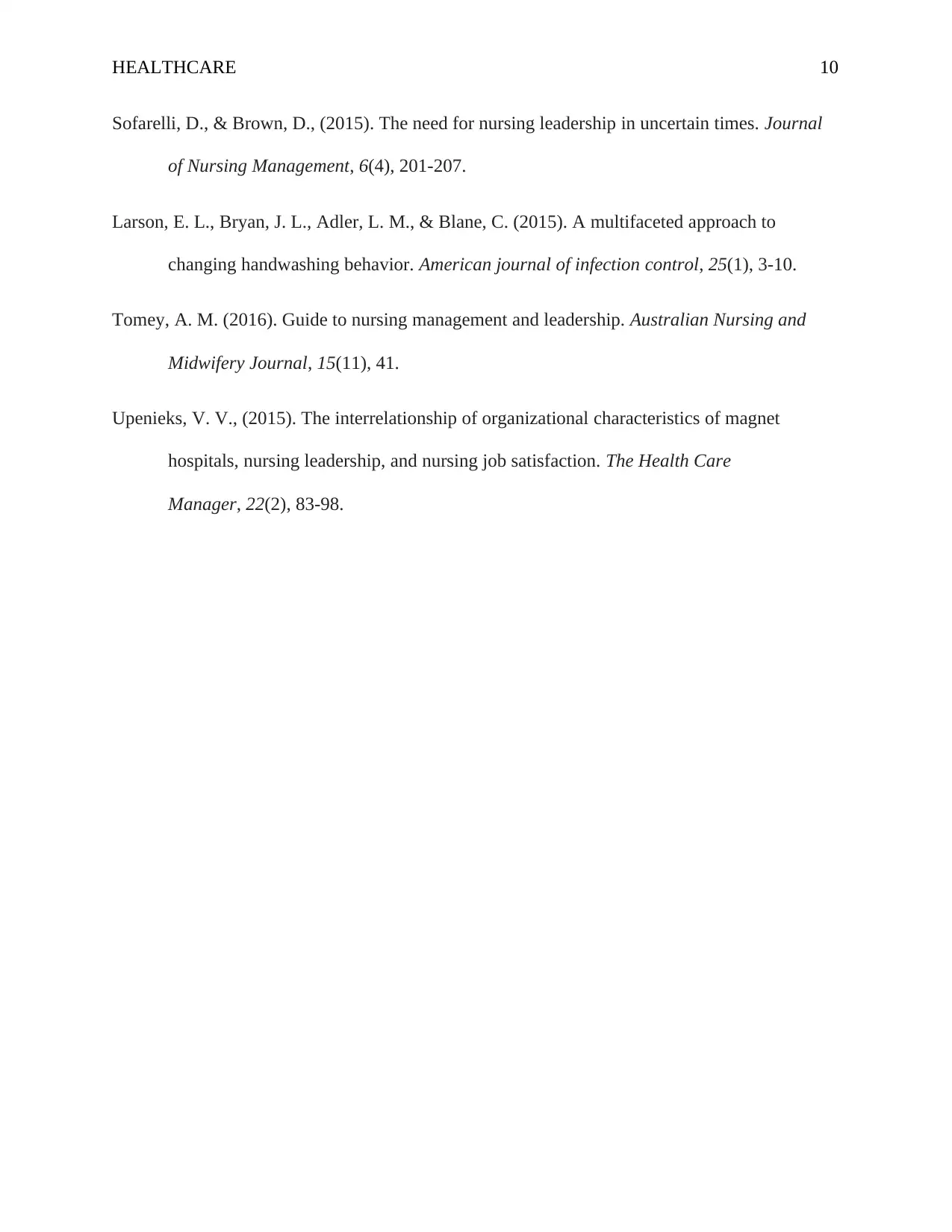
HEALTHCARE 10
Sofarelli, D., & Brown, D., (2015). The need for nursing leadership in uncertain times. Journal
of Nursing Management, 6(4), 201-207.
Larson, E. L., Bryan, J. L., Adler, L. M., & Blane, C. (2015). A multifaceted approach to
changing handwashing behavior. American journal of infection control, 25(1), 3-10.
Tomey, A. M. (2016). Guide to nursing management and leadership. Australian Nursing and
Midwifery Journal, 15(11), 41.
Upenieks, V. V., (2015). The interrelationship of organizational characteristics of magnet
hospitals, nursing leadership, and nursing job satisfaction. The Health Care
Manager, 22(2), 83-98.
Sofarelli, D., & Brown, D., (2015). The need for nursing leadership in uncertain times. Journal
of Nursing Management, 6(4), 201-207.
Larson, E. L., Bryan, J. L., Adler, L. M., & Blane, C. (2015). A multifaceted approach to
changing handwashing behavior. American journal of infection control, 25(1), 3-10.
Tomey, A. M. (2016). Guide to nursing management and leadership. Australian Nursing and
Midwifery Journal, 15(11), 41.
Upenieks, V. V., (2015). The interrelationship of organizational characteristics of magnet
hospitals, nursing leadership, and nursing job satisfaction. The Health Care
Manager, 22(2), 83-98.
1 out of 10
Related Documents
Your All-in-One AI-Powered Toolkit for Academic Success.
+13062052269
info@desklib.com
Available 24*7 on WhatsApp / Email
![[object Object]](/_next/static/media/star-bottom.7253800d.svg)
Unlock your academic potential
Copyright © 2020–2025 A2Z Services. All Rights Reserved. Developed and managed by ZUCOL.





